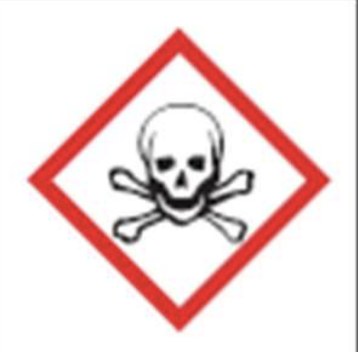Lab Safety
1/13
Earn XP
Description and Tags
Name | Mastery | Learn | Test | Matching | Spaced |
|---|
No study sessions yet.
14 Terms

?
Explosive
Explosives
Self-reactive substances
Organic peroxides

?
Flammable
Flammable gases, aerosols, liquids, and solids
Pyrophoric liquids or solids
Self-heating substances
Self-reactive substances
Substances that emit a flammable gas upon contact with water
Organic peroxides

?
Corrosive
Skin corrosion/burns
Eye damage
• Corrosive to metals

?
Oxidizer
• Oxidizing gases, liquids, and solids

?
Compressed gas
Gases under pressure

?
Toxic Substance
• Acutely toxic substances that may be fatal or toxic if inhaled, ingested, or absorbed through the skin

?
Irritant
Irritant (skin and eye)
Skin sensitizer
Acute toxins
Narcotic effects
Respiratory tract irritants
Hazardous to ozone layer (non-mandatory)

?
Health Hazard
* Respiratory sensitizers
• Carcinogens
• Mutagens
Reproductive toxins
Target organ toxins, single exposure or repeated exposure
• Aspiration toxins

?
Environmental Hazard (non-mandatory)
Acute aquatic toxins
Chronic aquatic toxins
Electrical Precautions
Before connecting equipment to a power source, examine all wiring for electrical defects and improper installation.
Grasp an electrical plug by the plug, not the cord, to remove it from the outlet.
Make sure that your hands are dry; that the work area is dry.
Follow directions. If you are unsure of any procedure, ask your teacher.
Attire
Safety glasses me be worn AT ALL TIMES.
Long hair must be tied back.
Closed-toe shoes must be worn at all times in the lab.
Jewelry must be removed.
Loose clothing (such as scarves or long sweaters) should be removed or secured.
Contacts may be worn in lab but be aware that if you should get chemical in your eyes you must take out and dispose of your lenses immediately.
Avoiding burns
Keep a lighted burner away from clothing, books, or other combustibles. Lean away from the top of the Bunsen Burner when it is being lit. Do not point test tubes that are being heated in the direction of another person or yourself.
Hot glass looks just like cold glass. Use care when touching glass objects that have been heated. Remember that glass, Bunsen burners, ring stands, tongs, any other metal objects and most items remain hot long after they have been removed from the heat source.
Do not heat anything inside a closed container.
Handling Chemicals
Always read the label of chemical supplies twice, and do not take more than needed
Do not return unused chemical to the original container.
Always put the lids back on chemical supplies.
4. Do not use unlabeled chemicals.
Dispose of chemical waste as directed. Solid material should go in the trash unless otherwise directed. Check with your teacher before disposing of chemical waste down the drain.
Never remove chemicals or lab materials from the lab area.
To smell the contents of a container, use a "wafting" action of the hand as demonstrated by your teacher.
Use care to avoid splattering of solutions when heating to dryness.
Always add acids to water SLOWLY, carefully, and with a gentle stirring action (solid glass rod only). This should generally be done in a large open beaker.
10. Take great care when transporting acids and other chemicals from one part of the laboratory to another. Hold them securely and walk carefully
General Safety
Keep your hands away from your face, eyes, and body, until they have been washed If a chemical is splashed or spilled on your skin, flush it with water for 20 minutes and tell your teacher right away. If you should get chemicals into your eyes, go directly to the eyewash fountain and gently flush with water. Report this immediately to your teacher. 7. 8 Do not eat, drink, chew gum or put on makeup while in the laboratory. Be tidy, and no clutter. Only necessary materials should be in the lab. Returned cleaned equipment to its proper place when finished. Report any damage of equipment to the instructor. Keep sinks clean and free of glassware. Never return chemicals to stock bottles. Handle only materials that you are assigned to work with. Use acids and bases with caution. Notify the teacher of any spills and clean up as directed Follow all instructions, both written and verbal. If you think some changes in procedu are necessary or desirable, check with your teacher. Never work alone. Clean up broken glassware with a broom and dustpan and dispose in the broken glassware box. If a thermometer is broken, do not handle it - notify your teacher. Do not immerse or fill hot glassware into/with cold water - it may shatter. Know where everything is and know what to do in case of a fire alarm. (Turn off flames or heat sources, turn off gas sources, cover chemicals or reactions, turn off all fume hoods and electrical equipment.) Never leave an experiment or equipment that is in use unattended. 20, Students are not permitted in the chemistry prep room.